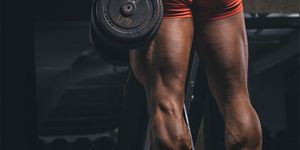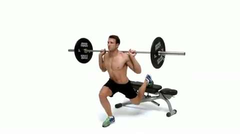Leg exercises fill even the most enthusiastic gym-goer with trepidation, and for good reason. The recovery period is longer and more painful. Results, being slow to materialise, are not as satisfying in the short term. Since they often recruit multiple muscles, leg exercises can be more taxing than most upper-body moves. And when your wheels do finally appear to grow, they’re hidden under jeans for 90 per cent of the year. Great.
With so many compelling reasons to skip leg day, why bother at all? Well stop that nonsense thinking right now.
Why Training Legs Is So Important
First and foremost, leg exercises target some of your body’s biggest muscles – the largest being your glutes – the foundations on which your fitness is built. Training legs means burning more calories, elevating your T-levels, boosting your big lifts, improving your mobility, and, of course, building strength, power and mass.
You might not know it, but leg exercises are also critical to brain and nervous system health. Your wheels send important signals to the brain that help produce neural cells (essential for handling stress and adapting to challenges) in particular during weight-bearing exercise, research published in Frontiers revealed.
On the flip side, skipping leg day one too many times can make you unbalanced and more susceptible to injury. If you play sports, you’ll be slower and weaker. And on a less scientific note, you will look ridiculous. Nobody wants that.
Like it or not, leg day is going nowhere, so logic dictates you should make full use of it. And when it comes to building muscle size, regularly changing exercises is just as effective as increasing the intensity of your workout, according to a study published in the Journal of Strength and Conditioning.
Don’t be all mouth and no trousers – hit the refresh button on your lower body routine with 20 of the best leg exercises below.
#1 Barbell Bulgarian Split Squat
Sets: 3
Reps: 6
Rest: 60 secs
How:
- Stand facing away from the bench, holding a barbell across your upper back. Have one leg resting on the bench behind you, laces down.
- Squat with your standing leg until the knee of your trailing leg almost touches the floor.
- Push up through your front foot to return to the start position.
Why: Scientists looked at muscle activation across a trio of unilateral barbell exercises: the split squat, single-leg squat and Bulgarian (or “rear foot elevated”) split squat in a study published in The Journal of Strength & Conditioning Research. While all three equally target the quads and glutes, this move is particularly effective at targeting the hamstrings, they concluded. “If you find having the barbell on your back causes you to excessively lean forward, try front loading or replacing with dumbbells by the side instead,” suggests Phillip Leonard, head of personal training at Ten Health & Fitness.
#2 Seated Dumbbell Calf Raise
Sets: 3
Reps: 6
Rest: 60 secs
How:
- Put a weight plate on the floor and rest your toes on it whilst sitting on a bench.
- Place a dumbbell on your knee, your right hand holding the handle whilst your left hand holds the top.
- Lift up your toes as high as possible. Pause, then lower it back onto the weight and repeat.
Why: “The seated variation deactivates the hamstrings – the focus goes entirely to the soleus,” explains Jonathan Dick, Tier X coach at Equinox Kensington. “Strengthening your calves can help treat shin splints if you’re spending too much time on the treadmill.” Being notoriously stubborn in terms of muscle growth, your calves will reap the benefits of a little concentrated effort.
#3 Romanian Deadlift
How:
- Stand behind a grounded barbell. Bend your knees slightly to grab it, keeping your shins, back and hips straight.
- Without bending your back, push your hips forwards to lift the bar. From upright, push your hips back to lower the bar, bending your knees only slightly.
Why: “It’s a great variation on the traditional deadlift that focuses on your glutes and superior end of your hamstrings,” says Leonard. Practising hip flexion exercises – like the Romanian deadlift – can seriously improve your sprint speed and agility. After eight weeks of hip flexor-specific training, participants in a University of Florida study saw their sprint and shuttle run PBs improve by around four per cent and nine per cent respectively.
#4 Goblet Squat
Sets: 3
Reps: 6
Rest: 60 secs
How:
- Stand with your legs wider than your shoulders and hold a dumbbell with both hands in line with your thighs.
- Stick your backside out, bend your knees and lower yourself into a squat until the dumbbell touches the floor. Drive back up and repeat.
Why: You get the lower body muscle-building benefits reaped from traditional squats while torching your shoulders and arms at the same time. “Goblet squats are a great alternative for those who lack the shoulder mobility to maintain proper back squat form,” says Dick. “Positioning the load in the front of the body will challenge the core and quadriceps more.”
#5 Barbell Side Lunge
Sets: 3
Reps: 6
Rest: 60 secs
How:
- Stand with your legs under your hips and hold a barbell on your back.
- Step your right leg out to the side and lower your body as you bend your knee, keeping your left leg straight.
- Drive yourself back up to starting position and repeat on the other side.
Why: You’ll be a far more agile sportsman. Lateral lunges place emphasis on your hip adductors and abductors, the School of Physiotherapy and Exercise Science reports, making it beneficial for the “very tight sidestepping manoeuvres” required in American football, rugby, basketball and skiing. “If you find it difficult to keep an upright torso, try placing a wedge under the heel of the bent leg,” says Leonard. “This will reduce the amount of hip flexion required, allowing for a more upright position.”
#6 Good Morning
Sets: 3
Reps: 6
Rest: 60 secs
How:
- Place a barbell across your shoulders behind your neck. Ensure your shoulder blades are pushed back to take the weight off the bar.
- Brace your core and slowly bend at the hips to lower your head towards the floor. Pause at the bottom, then reverse.
Why: It’s excellent for building the solid foundations that your big lift PBs depend upon. “This is a great posterior chain exercise to strengthen both hamstrings and glutes, while challenging the core,” explains Dick. “Try taking a wider-than-shoulder-width foot position, or ‘sumo’ stance, to really target the glutes.”
#7 Battle Ropes Reverse Lunge
Sets: 3
Reps: 6
Rest: 60 secs
How:
- Hold the ends of the rope in each hand with your thumbs parallel, and your feet shoulder-width apart in an athletic stance.
- Swing your arms up and down in a constant, controlled motion, moving the rope in a wave motion, as you simultaneously step back and lower your knee to the ground to lunge, one leg at a time.
Why: Reverse lunges boast all the benefits of regular lunges, but they’re much easier on the knees. Left to our own devices, most of us have a tendency to send our knees past our toes: a high-risk injury zone. Lunging in reverse eliminates that risk. “To make it extra spicy and increase the glute focus, start with both feet on a low box and step back and down into more depth,” Leonard suggests.
#8 Kettlebell Pistol Squat
Sets: 3
Reps: 6
Rest: 60 secs
How:
- Hold one kettlebell with both hands just under your chin.
- Lift one leg off the floor and squat down with the other.
- Drive through the heel and bring yourself back up to standing position, without letting your leg touch the floor. Lower back down and repeat.
Why: “A great single leg exercise to challenge hip mobility and stability that transfers over directly to daily life,” says Dick. It’s also incredibly tricky to master, requiring strength, dexterity and balance in equal measure – giving those who can execute it flawlessly a free pass to gloat.
#9 Hip Thruster
Sets: 3
Reps: 6
Rest: 60 secs
How:
- Lean the top of your back against a bench, creating a 45-degree angle between yourself and the support.
- Squeeze your glutes and core and raise your hips to lift the load until your back is straight and your knees form a 90-degree angle. Return to the starting position.
Why: Hip thrusters build power in your glutes like no other. Your derriere might not be an aesthetic priority, but it should be from a training perspective – weak glutes have a negative impact on the movement mechanics of your entire leg, which spells trouble for your knee joints and ankles. “Bullet-proof your technique with a strong brace before pushing into the lift,” says Leonard. “Make sure to squeeze those glutes as hard as you can, holding the top position for at least a split second.”



